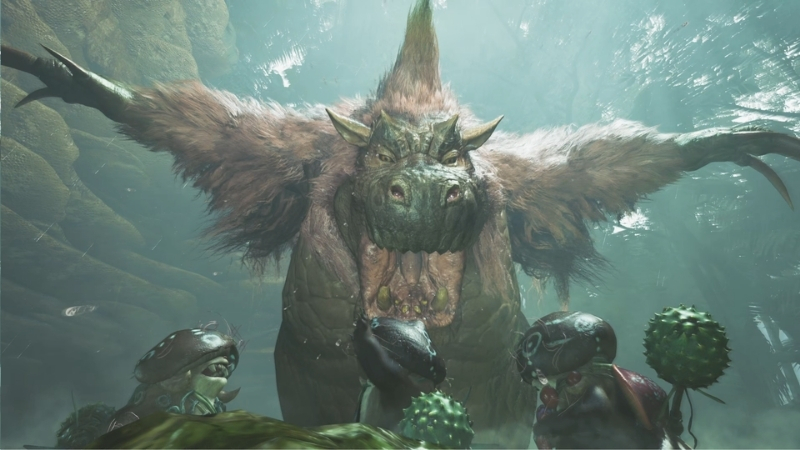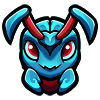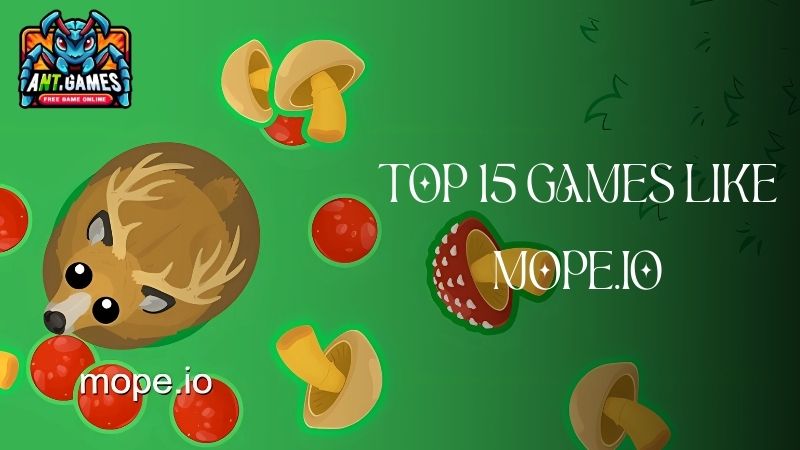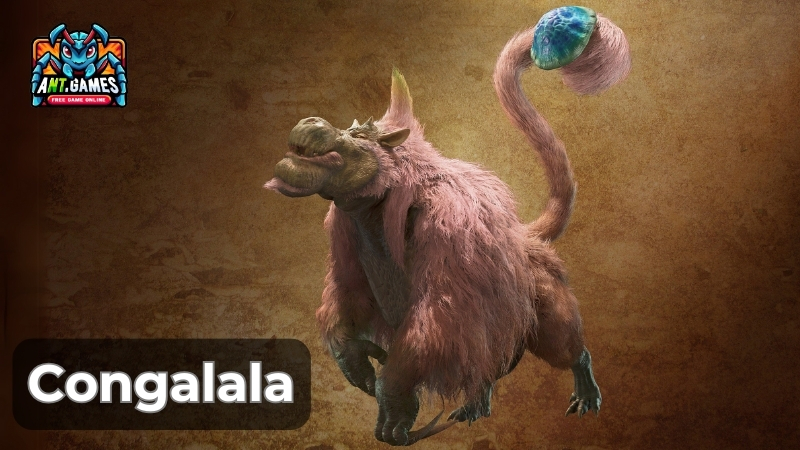Congalala dominates as a vibrant Fanged Beast in Monster Hunter Wilds, its pink fur and noxious attacks leaving a bold mark in the Scarlet Forest. Reintroduced from Monster Hunter 2, this ape-like monster brings enhanced visuals and cunning tactics to the hunt. With mushroom-fueled breath unleashing poison, paralysis, or blastblight, and fart clouds that lock items in a stifling haze, Congalala demands quick thinking from hunters facing its chaotic onslaught.
Congalala’s Physical Characteristics
Congalala is a large, ape-like monster with distinctive pink fur and a head resembling a hippopotamus. Its most notable feature is the crest on its head, actually hair styled by males using plant oils to signify pack leadership. It boasts long front claws and a prehensile tail, often used to hold mushrooms for later consumption.
Adapted to temperate forests, Congalala thrives in humid, warm environments like the Scarlet Forest, where its physical traits aid in climbing and foraging. Compared to other Fanged Beasts like Rajang, Congalala’s less aggressive demeanor and unique appearance make it stand out, though its size and strength are not to be underestimated.

Congalala’s Behavior and Combat Abilities
Congalala’s behavior revolves around its voracious appetite, particularly for mushrooms, which directly influence its combat abilities. By consuming different mushrooms, it can exhale breaths that inflict poison, blast, paralysis, or other status effects.
It’s typically docile but becomes aggressive when startled or during feeding disruptions, often accompanied by smaller Conga monsters. In combat, Congalala uses physical attacks like claw swipes and body slams, alongside its infamous gas attacks that cause stench, preventing item use.
Key Attacks
- Breath Attacks: Vary by mushroom type (e.g., Purple Toadstool for poison, Red Nitroshroom for blastblight).
- Fart Attacks: Inflict stench, disabling item use; can cause dragon-strength wind in some variants.
- Physical Attacks: Includes lunges, body slams, and territorial dung throws.
Counters
- Use deodorants or evade in water to remove stench.
- Bring antidotes for poison and nulberries for paralysis or blastblight.
- Target the head and rear for maximum damage; interrupt eating to limit breath attacks.
- Use Large Dung Pods to disperse smaller Congas.

Where to Encounter Congalala in the Game
Congalala primarily inhabits the Scarlet Forest, favoring areas rich in honey and mushrooms, and occasionally appears in the Ruins of Wyveria. Hunters first encounter it in the main story quest “Drive Off the Congalala,” after which it becomes a regular spawn in the Scarlet Forest.
Optional quests like “Tussle in Pink” also feature Congalala, accessible any time of day or season. While no specific event quests tied to the Festival of Accord: Blossomdance explicitly feature Congalala, its presence in the Scarlet Forest makes it a likely target during seasonal event challenges, offering unique rewards like Blossomdance Tickets for crafting event gear.
|
Quest Name |
Location |
Conditions |
| Drive Off the Congalala | Scarlet Forest | Main Story Quest, post-story unlock |
| Tussle in Pink | Scarlet Forest | Optional Quest, any season |
| Event Quest (Potential) | Scarlet Forest | Festival of Accord: Blossomdance (April 22–May 6, 2025) |

Discover: 48 Monster in Monster Hunter Wilds
Combat Strategies for Defeating Congalala
Defeating Congalala requires careful preparation due to its status-inflicting attacks and smaller Conga allies. Below are detailed strategies for both new and veteran hunters, applicable to standard and potential event variants.

Recommended Equipment
- Weapons: Use high-damage non-elemental weapons, as Congalala has near-equal resistance to all damage types. Fire weapons offer a slight advantage when targeting the head (IGN Guide).
- Armor Skills: Equip Poison Resistance, Paralysis Resistance, Blast Resistance, and Stench Resistance to mitigate status effects. The Intimidator skill helps deter smaller Congas.
- Mantles: Mending Mantle aids recovery during paralysis or stench; Rocksteady Mantle boosts durability.
Tactics
- Eliminate Congas: Clear smaller Congas first to avoid combo interruptions, using Large Dung Pods for dispersal (Game8 Guide).
- Monitor Diet: Watch for Congalala eating mushrooms; interrupt with attacks to the tail to drop the mushroom, preventing breath attack changes.
- Target Weak Points: Focus on the head (Sever: 13, Blunt: 14, Shot: 12) and rear for maximum damage. Breaking the head yields extra rewards.
- Avoid the Belly: The belly is tough (Sever: 7, Blunt: 7, Shot: 7) and may cause attacks to bounce when inflated; attack from behind or sides.
- Environmental Advantage: Use Flashflies, Dark Hornet Nests, Pitfall Traps, or Shock Traps to immobilize or distract Congalala.
Items to Bring
- Deodorants (for stench)
- Antidotes or Herbal Medicines (for poison)
- Nulberries (for paralysis, blastblight)
- Pitfall and Shock Traps
- Large Dung Pods
- Potions, Mega Potions, Max Potions
- Flash Pods
Event Variant Considerations
While no Arch-Tempered Congalala is confirmed, potential event quests during the Festival of Accord: Blossomdance may feature enhanced versions. Prepare for increased status effect potency and bring extra resistance skills or items.
Official In-Game Description and Lore
“Large fanged beasts with pink fur and a distinct crest, which the males sculpt with plant oils and juices as a sign of virility. Congalala are common in temperate forests and are therefore well researched. They’re big eaters and love mushrooms, which they absorb and then exhale as a variety of potent breaths that inflict poison, blast, paralysis, and more.”
In Monster Hunter Wilds, Congalala is a key player in the Scarlet Forest’s ecosystem, acting as both predator and scavenger. Its turf wars with monsters like Rathian and Doshaguma showcase its territorial nature, adding depth to the game’s world.
The monster’s diet-driven abilities reflect the series’ emphasis on ecological interactions, with Congalala’s mushroom consumption tying it to the forest’s flora. Its role in the narrative, particularly in quests like “Drive Off the Congalala,” underscores its impact on local Wudwud communities, who view it as a disruptive force.
Discover more types of other Fanged Beasts: Doshaguma
Fascinating Facts and Trivia About Congalala
While Monster Hunter Wilds is known for its intense battles, it also features monsters that bring a lighter, more humorous touch to the game. Let’s take a closer look at Congalala, a fan-favorite with a quirky design and some truly fascinating traits.
- Design Inspiration: Congalala’s appearance draws from primates like gorillas and baboons, with a hippo-like head, creating a unique, comical aesthetic.
- Fan Nicknames: Known as the “fart monkey” among players, reflecting its gas-based attacks, as seen in X posts (MHWildsHammer).
- Cultural Moments: An April Fools’ quest in Monster Hunter Online featured Congalala, cementing its humorous reputation.
- Community Engagement: X posts show excitement for its Wilds return, with fans sharing memes and hoping for quirky mechanics (JoshAnimator).
- Unique Mechanic: Its diet-based breath attacks add unpredictability, a trait praised for strategic depth.
Congalala’s comical antics in Monster Hunter Wilds belie its threat as a Fanged Beast, with unpredictable breath attacks and status-inflicting moves that test any hunter’s skill. Its vibrant pink fur and quirky habits, like farting and dung-throwing, make it a memorable foe in the Scarlet Forest. To prevail, hunters must exploit weak points, counter status effects, and use the environment wisely. Whether tackling it solo or during vibrant seasonal hunts, Congalala delivers a thrilling mix of challenge and charm. Gear up, dive into the wilds, and face this chaotic beast head-on!





